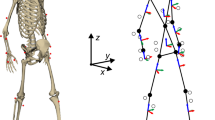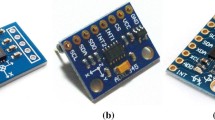Abstract
The paper studies a surface electromyogram (SEMG) decomposition technique suitable for identification of complete motor unit (MU) firing patterns and their motor unit action potentials (MUAPs) during low-level isometric voluntary muscle contractions. The algorithm was based on a correlation matrix of measurements, assumed unsynchronised (uncorrelated) MU firings, exhibited a very low computational complexity and resolved the superimposition of MUAPs. A separation index was defined that identified the time instants of an MU's activation and was eventually used for reconstruction of a complete MU innervation pulse train. In contrast with other decomposition techniques, the proposed approach worked well also when the number of active MUs was slightly underestimated, if the MU firing patterns partly overlapped and if the measurements were noisy. The results on synthetic SEMG show 100% accuracy in the detection of innervation pulses down to a signal-to-noise ratio (SNR) of 10 dB, and 93±4.6% (mean± standard deviation) accuracy with 0 dB additive noise. In the case of real SEMG, recorded with an array of 61 electrodes from biceps brachii of five subjects at 10% maximum voluntary contraction, seven active MUs with a mean firing rate of 14.1 Hz were identified on average.
Similar content being viewed by others
References
Amari, S. I., Hyvarinen, A., Lee, T. W., andSánchez, V. D. A. (2002): ‘Blind signal separation and independent component analysis’,Neurocomputing,49, pp. 1–5
Balestra, G., Frassinelli, S., Knaflitz, M., andMolinari, F. (2001): ‘Time-frequency analysis of surface myoelectric signals during athletic movement’,IEEE Eng. Med. Biol.,20, pp. 106–115
Barros, A. K., Mansour, A., andOhinisi, N. (1999): ‘Removing artefacts from ECG signals using independent components analysis’Neurocomputing,22, pp. 173–186
Clancy, E. A., Hogan, N. (1999): ‘Probability density of the surface electromyogram and its relation to amplitude detectors’,IEEE Trans. Biomed. Eng.,46, pp. 730–739
De Luca, C. J., Foley, P. J. andErim, Z. (1996): ‘Motor unit control properties in constant-force isometric contractions’,J. neurophysiol.,76, pp. 1503–1516
Disselhorst-Klug, C., Rau, G., Schmeer, A., andSilny, J. (1999): ‘Non-invasive detection of the single motor unit action potential by averaging the spatial potential distribution triggered on a spatially filtered motor unit action potential’,J. Electromyogr. Kinesiol.,9, pp. 67–72
Fallentin, N., Jorgensen, K., andSimonsen, E. B. (1993): ‘Motor unit recruitment during prolonged isometric contraction’,Eur. J. Appl. Physiol. Occupat. Physiol.,67, pp. 335–341
Farina, D., Fortunato, E., andMerletti, R. (2000): ‘Non-invasive estimation of motor unit conduction velocity distribution using linear electrode arrays’,IEEE Trans. Biomed. Eng.,47, pp. 380–388
Farina, D., Colombo, R., Merletti, R., andOlsen, H. B. (2001): ‘Evaluation of intra-muscular EMG signal decomposition algorithms’,J. Electromyog. Kinesiol.,11, pp. 175–187
Farina, D., andMerletti, R. (2001): ‘A novel approach for precise simulation of the EMG signal detected by surface electrodes’,IEEE Trans. Biomed. Eng.,48, pp. 637–646
Golub, G. H., andVan Loan, C. F. (1989): ‘Matrix computations’ (John Hopkins University Press, Baltimore, USA, 1989).
Holobar, A., andZazula, D. (2003): ‘Surface EMG decomposition using a novel approach for blind source separation’,Informatica Medica Slovenica,8, pp. 2–14
Merletti, R. (1994): ‘Surface electromyography: possibilities and limitations’,J. Rehab. Sci.,7, pp. 25–34
Merletti, R., Knaflitz, M., andDe Luca, C. J. (1994): ‘Myoelectric manifestations of fatigue in voluntary and electrically elicited contractions’,J. Appl. Physiol.,77, pp. 2104–2114
Micera, S., Vannozzi, G., Sabatini, A. M., andDario, P. (2001): ‘Improving detection of muscle activation intervals’,IEEE Eng. Med. Biol.,20 (6), pp. 38–47
Weytjens, J. L. F., andVan Steenberhe, D. (1984): ‘The effects of motor unit synchronisation on the power spectrum of the electromyogram’,Biol. Cybern.,51, pp. 71–77
Zazula, D., andPlevin, E. (2002): ‘An approach to decomposition of muscle and nerve signals’. Proc. WSEAS Int. Conf., 2002, Skiathos, Greece,1, pp. 1351–1356
Author information
Authors and Affiliations
Corresponding author
Rights and permissions
About this article
Cite this article
Holobar, A., Zazula, D. Correlation-based decomposition of surface electromyograms at low contraction forces. Med. Biol. Eng. Comput. 42, 487–495 (2004). https://doi.org/10.1007/BF02350989
Received:
Accepted:
Issue Date:
DOI: https://doi.org/10.1007/BF02350989




